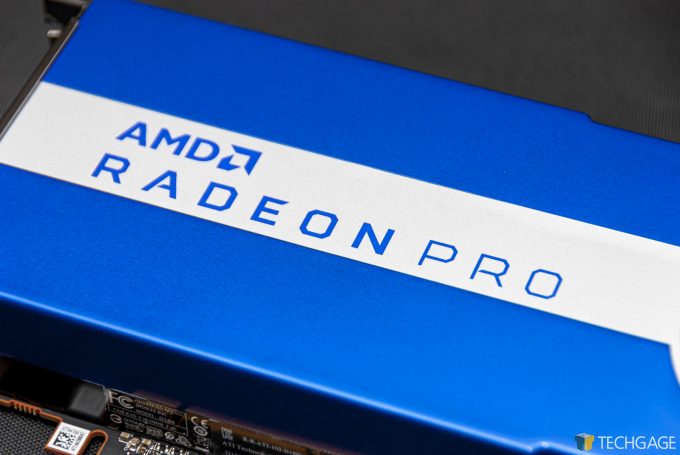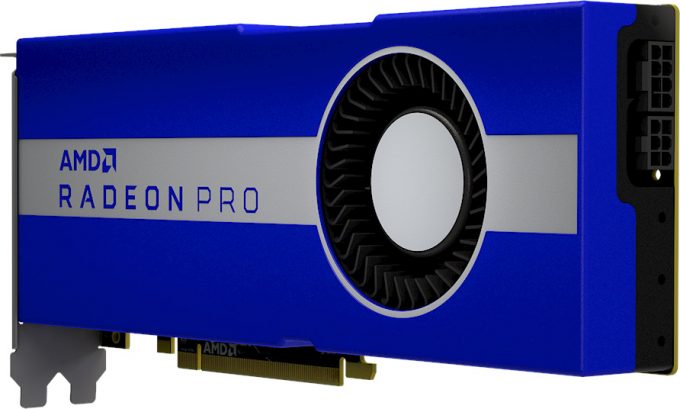- Qualcomm Launches Snapdragon 4 Gen 2 Mobile Platform
- AMD Launches Ryzen PRO 7000 Series Mobile & Desktop Platform
- Intel Launches Sleek Single-Slot Arc Pro A60 Workstation Graphics Card
- NVIDIA Announces Latest Ada Lovelace Additions: GeForce RTX 4060 Ti & RTX 4060
- Maxon Redshift With AMD Radeon GPU Rendering Support Now Available
Navi For Workstation: A Performance Review Of AMD’s Radeon Pro W5700

AMD has augmented its Radeon Navi lineup with its first workstation card: the Radeon Pro W5700. This 8GB card shares traits with the RX 5700, but with optimizations in place, it can sometimes exceed expectations. We’re pitting AMD’s latest against NVIDIA’s Quadro RTX 4000, and a handful of others.
Page 6 – Final Thoughts
As with most of our workstation graphics card reviews, it’s hard to sum up AMD’s Radeon Pro W5700 without breaking down what it’s good at. We have many results spread across the previous pages that can highlight just how much performance can change from one vendor to the next, or even from workstation to gaming series.
In our rendering tests, the W5700 performed great for its price point as a workstation GPU. For heavier workloads, it goes without saying that you’re going to greatly value a higher-end option than the W5700 (or competing RTX 4000). By saying that, we’re talking workloads that see renders span many hours, not just minutes. Those familiar with the need for top-end GPUs are no doubt familiar with overnight renders.
Where rendering is king, and budgets are tight, gaming cards are almost always a better choice, unless you’re dealing with some serious software (eg: SolidWorks, CATIA, Siemens, et cetera.) You also have the option of using a lower-end Radeon Pro as the primary GPU, and dedicate a secondary gaming GPU (also Radeon) to rendering duties. Both GPUs could even be used at the same time. Your choice of hardware will largely revolve around your specific requirements.
AMD’s Navi architecture has proven to be a great one for Blender Cycles use, with the W5700 actually managing to surpass the (technically quicker) RX 5700 XT in the more complex Classroom scene. We’d be remiss to not mention the fact that NVIDIA has accelerated Cycles rendering quite a bit with its RTX technologies, something we took a look at a couple of months ago. This tech is currently in beta, but it is impressive, and makes us wish AMD had its own ray tracing solution ready-to-go.
While rendering is great with the W5700, the video encoding performance leaves a little bit to be desired – but again, what impacts you depends on your workflow. AMD had strong performance in our AVC and RED transcodes, but it fell behind NVIDIA with ProRes. That detriment carried over to the BRAW Speed Test, which showed NVIDIA with double the performance.
We’re of the mind that video encoding performance will improve over time, not just as AMD iterates on its drivers, but as software developers better support the Navi architecture. Despite the fact that Navi launched on July 7, MAGIX Vegas Pro 17 still doesn’t support it (or else it would have been included here). We’re told that the next build should add support, and we’re hoping that one will land before we finish testing for our next general ProViz performance look, since AMD tends to be strong there.
The viewport tests are where the real fun happens, because it’s basically a free-for-all to see which GPU will come out on top. While gaming GPUs will work fine in many of these applications, performance isn’t everything. Workstation graphics drivers are specifically vetted for stability in all of their supported applications. For a regular end-user sitting at home doing stuff as a hobby, a gaming GPU can easily fit the bill (depending on workload), but for more critical work, workstation GPUs are suggested.
We have to admit that the W5700 surprised us with its super-strong performance in SPECviewperf. In SolidWorks, Siemens NX, and Maya, it led the pack, and traded blows based on resolution in CATIA. While super-high performance will be enjoyed by those with high-refresh monitors, it’s nice to know if there’s anything holding back performance, it’s not going to be the GPU.
Overall, AMD’s Radeon Pro W5700 is a great workstation graphics card for the money. Ultimately, though, what turns out to be the best choice for you will depend entirely on your workflows. It’s an unrelenting fact that it pays to know your workload, and as our results have highlighted once again, they’re all far from being alike.
Pros
- Delivers solid performance all-around for its price point.
- Against the competition, it has an edge in SVP’s SolidWorks, CATIA, and Maya tests.
- Offers blanket 10-bit OpenGL support for select creative applications (over Radeon).
- The first Radeon to include built-in USB-C.
Cons
- No built-in accelerators to compete with NVIDIA’s Tensor and RT cores.
- Video encoding performance and support (from vendors) is hit-or-miss right now.
Support our efforts! With ad revenue at an all-time low for written websites, we're relying more than ever on reader support to help us continue putting so much effort into this type of content. You can support us by becoming a Patron, or by using our Amazon shopping affiliate links listed through our articles. Thanks for your support!







